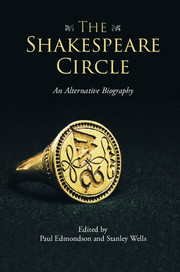Book contents
- Frontmatter
- Contents
- List of illustrations
- List of contributors
- Preface and acknowledgements
- General introduction
- Part I Family
- 1 His Mother Mary Shakespeare
- 2 His father John Shakespeare
- 3 His siblings
- 4 His sister's family: the Harts
- 5 His wife Anne Shakespeare and the Hathaways
- 6 His daughter Susanna Hall
- 7 His son-in-law John Hall
- 8 His son Hamnet Shakespeare
- 9 His daughter Judith and the Quineys
- 10 His granddaughter Lady Elizabeth Barnard
- 11 His ‘cousin’: Thomas Greene
- Part II Friends and Neighbours
- Part III Colleagues and Patrons
- Closing remarks
- Afterword
- Index
- References
3 - His siblings
from Part I - Family
Published online by Cambridge University Press: 05 November 2015
- Frontmatter
- Contents
- List of illustrations
- List of contributors
- Preface and acknowledgements
- General introduction
- Part I Family
- 1 His Mother Mary Shakespeare
- 2 His father John Shakespeare
- 3 His siblings
- 4 His sister's family: the Harts
- 5 His wife Anne Shakespeare and the Hathaways
- 6 His daughter Susanna Hall
- 7 His son-in-law John Hall
- 8 His son Hamnet Shakespeare
- 9 His daughter Judith and the Quineys
- 10 His granddaughter Lady Elizabeth Barnard
- 11 His ‘cousin’: Thomas Greene
- Part II Friends and Neighbours
- Part III Colleagues and Patrons
- Closing remarks
- Afterword
- Index
- References
Summary
Forasmuch as it hath pleased almighty God of his great mercy to take until him self the soul of our dear brother here departed: we therefore commit his body to the ground.
(1561, Pi iii)William Shakespeare had four siblings who survived into adulthood. Two years after he was born a brother, Gilbert, arrived, and three years after that a sister, Joan, about whom you can read elsewhere in this volume; in 1574, when Shakespeare was 10, Richard arrived and finally, when he was 16, Edmund.
Gilbert, who may have been named after Gilbert Bradley, a glover living close to the family in Henley Street, apparently spent most of his life in Stratford, where he often appears in the records, sometimes acting for William. He did not marry, and died in 1612. There is also, however, a record of a Gilbert Shackspere listed in 1597 as a haberdasher of St Bride's in London, standing surety for William Sampson, a clockmaker from Stratford-upon-Avon. This may be the same Gilbert, but new evidence would be required to be sure.
About Richard we know next to nothing. Between his baptism on 11 March 1574 and burial on 4 February 1613, he made one appearance in the ecclesiastical court in 1608 on an unspecified charge, and paid a fine of 12d to the poor for his fault (Schoenbaum 1975, p. 28).
Finally Edmund, probably named after Edmund Lambert, his mother's brother-in-law, became an actor in London. In August 1607 a child who appears to be his illegitimate son was buried in St Giles Cripplegate (Schoenbaum 1975, p. 29). In the cruel winter which followed in which the Thames froze before Christmas, Edmund himself was buried on 31 December in an expensive funeral in St Saviour's Southwark, between London Bridge and the Globe. Someone, perhaps William, paid 20 shillings to have him buried in the church rather than the churchyard, and had him honoured ‘with a forenoon knell of the great bell’. The words at the head of this chapter are part of the ‘Order for the Burial of the Dead’ which would have been spoken over his body. They invite us to think about the many meanings of that phrase ‘dear brother’.
- Type
- Chapter
- Information
- The Shakespeare CircleAn Alternative Biography, pp. 40 - 48Publisher: Cambridge University PressPrint publication year: 2015
References
- 1
- Cited by

